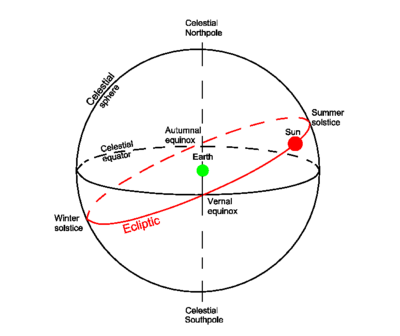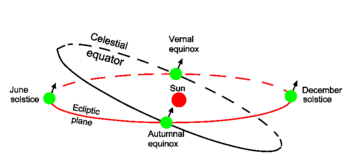Ecliptic: Difference between revisions
imported>Paul Wormer No edit summary |
imported>Paul Wormer No edit summary |
||
| Line 1: | Line 1: | ||
[[Image:Ecliptic1.png|right|thumb|400px||The ecliptic is in red.]] | [[Image:Ecliptic1.png|right|thumb|400px||The ecliptic is in red.]] | ||
In [[astronomy]], the '''ecliptic''' is the circle intersecting the ecliptic plane and the celestial sphere. The ecliptic plane contains the Earth and the apparent orbit of the Sun (as seen from the Earth). Equivalently, the ecliptic plane may be defined as the plane of the orbit of the Earth around the Sun. The Earth is the center of the celestial sphere and the celestial equator is a circle in the same plane as the equator of the Earth. The plane of the equator makes an angle of approximately 23.5<sup>0</sup>, which is the slope of the ecliptic. Obviously, this is the complement of the angle that the rotation axis (North-South axis) of the Earth makes with the ecliptic. | In [[astronomy]], the '''ecliptic''' is the circle intersecting the ecliptic plane and the celestial sphere. The ecliptic plane contains the Earth and the apparent orbit of the Sun (as seen from the Earth); see Fig. 1. Equivalently, the ecliptic plane may be defined as the plane of the orbit of the Earth around the Sun; see Fig. 2. [[Image:Orbit Earth.png|left|thumb|350px||Fig. 2. The Earth in its orbit around the Sun.]] | ||
The Earth is the center of the celestial sphere and the celestial equator is a circle in the same plane as the equator of the Earth. The plane of the equator makes an angle of approximately 23.5<sup>0</sup>, which is the slope of the ecliptic. Obviously, this is the complement of the angle that the rotation axis (North-South axis) of the Earth makes with the ecliptic. | |||
The intersections of the equator and the ecliptic are the ''vernal equinox'' (the date in spring that day and night are equally long, around March 21) and the ''autumnal equinox'' (the date in the fall that day and night are equally long, around September 21). The solstices are the dates that the Sun seems to stand still (around June 21 and December 21). | The intersections of the equator and the ecliptic are the ''vernal equinox'' (the date in spring that day and night are equally long, around March 21) and the ''autumnal equinox'' (the date in the fall that day and night are equally long, around September 21). The solstices are the dates that the Sun seems to stand still (around June 21 and December 21). | ||
Revision as of 11:22, 29 October 2008
In astronomy, the ecliptic is the circle intersecting the ecliptic plane and the celestial sphere. The ecliptic plane contains the Earth and the apparent orbit of the Sun (as seen from the Earth); see Fig. 1. Equivalently, the ecliptic plane may be defined as the plane of the orbit of the Earth around the Sun; see Fig. 2.
The Earth is the center of the celestial sphere and the celestial equator is a circle in the same plane as the equator of the Earth. The plane of the equator makes an angle of approximately 23.50, which is the slope of the ecliptic. Obviously, this is the complement of the angle that the rotation axis (North-South axis) of the Earth makes with the ecliptic.
The intersections of the equator and the ecliptic are the vernal equinox (the date in spring that day and night are equally long, around March 21) and the autumnal equinox (the date in the fall that day and night are equally long, around September 21). The solstices are the dates that the Sun seems to stand still (around June 21 and December 21).

